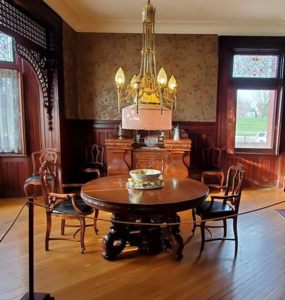
Portland is a neighborhood and former independent town northwest of downtown Louisville, Kentucky. It is situated along a bend of the Ohio River just below the Falls of the Ohio, where the river curves to the north and then to the south, thus placing Portland at the northern tip of urban Louisville. In its early days it was the largest of the six major settlements at the falls, the others being Shippingport and Louisville in Kentucky and New Albany, Clarksville, and Jeffersonville on the Indiana side. Its modern boundaries are the Ohio River along the northwest, north, and northeast, 10th Street at the far east, Market Street on the south, and the Shawnee Golf Course at the far west.

Culbertson Mansion State Historic Site is located in New Albany, Indiana by the Ohio River. It was the home of William Culbertson, who was once the richest man in Indiana. Built in 1867 at a cost of $120,000, this Second Empire-style mansion has 25-rooms within 20,000 square feet (1,900 m2), and was completed in November 1869. It was designed by James T. Banes, a local architect. Features within the three-story edifice include hand-painted ceilings and walls, frescoed ceilings, carved rosewood-grained staircase, marble fireplaces, wallpaper of fabric-quality, and crystal chandeliers. The original tin roof was imported from Scotland. The displays within the mansion feature the Culbertson family and the restoration of the building. The rooms on the tour are the formal parlors, dining rooms, bedrooms, kitchen, and laundry room.

The Old Jeffersonville Historic District is located in Jeffersonville, Indiana, United States. It marks the original boundaries of Jeffersonville, and is the heart of modern-day downtown Jeffersonville. It was placed on the National Register of Historic Places in 1983. The area is roughly bounded by Court Avenue at the North, Graham Street on the east, the Ohio River at the south, and Interstate 65 at the west. In total, the district has 203 acres (0.8 km2), 500 buildings, 6 structures, and 11 objects. Several banks are located in the historic buildings in the district. The now defunct Steamboat Days Festival, held on the second weekend in September, used to be held on Spring Street and the waterfront. Jeffersonville's largest fire wiped out a block in the historic district on January 11, 2004 which destroyed the original Horner's Novelty store.

The Henry French House, also known as the Salmon-French House, is a historic house located in the Port Fulton area of Jeffersonville, Clark County, Indiana in the United States. It was built about 1832, and is a two-story, Federal style brick dwelling with a rear ell added about 1839 to form an I-house. It has some Colonial Revival style design elements.

Port Fulton was a town located two miles up the river from Louisville, within present-day Jeffersonville, Indiana. At its height it stretched from the Ohio River to modern-day 10th Street, and from Crestview to Jefferson/Main Streets.
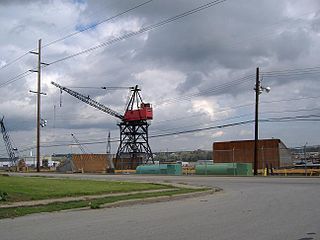
Jeffboat was a shipyard in Jeffersonville, Indiana founded by James Howard in 1834, a builder of steamboats. The company was owned by the Howard family until it was sold leading up to World War II. Following the war, it became known as the Jeffersonville Boat and Machine Company and later changed its name to Jeffboat, the more commonly used short form of its name. The company was the largest inland shipbuilder in the United States and the second-largest builder of barges before it closed in 2018.

The Washington County Courthouse is a historic courthouse located at Salem, Washington County, Indiana. It was designed by Harry P. McDonald and his brother, both of Louisville, and built in 1886. It is a Richardsonian Romanesque building and faced with limestone from the area was used in the construction. It is two-stories above a raised basement and features a five-story corner clock tower with a conical roof. It is the third courthouse at that location.
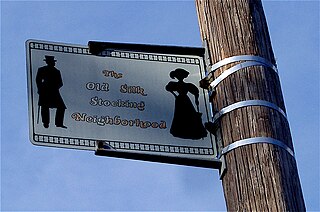
The Old Silk Stocking Neighborhood is the historic district near downtown Kokomo, Indiana, and the Westside Business District. In 1886, natural gas was discovered in north central Indiana. The area exploded with people, who then developed the neighborhood. This historic area of town was the place where lawyers, doctors, industrialists and even a mayor would come to build their turn of the century residences.

The Guy C. Barton House was a very elaborate and expensive Victorian home in the Midtown area of Omaha, Nebraska, United States, a home and entertaining center of an industrialist and philanthropist. The house caught fire and was demolished in 1982.

The John N. Bagley House, also known as Bagley Mansion, was built as a private residence in 1889. The mansion is located at 2921 East Jefferson Avenue in Detroit, Michigan. It was listed on the National Register of Historic Places in 1985. As of 2022, the house is used as a commercial office building, maintaining its historic features and character.

The Josephus Wolf House is a Victorian Italianate mansion in Portage, Indiana built in 1875. The farm consisted of 4,500 acres (1,800 ha) in Portage Township, Porter County. It was the center piece of a family farm that included four additional buildings for beef and dairy animals. The three story house has 7,800 square feet (720 m2). The house consists of 18 rooms with pine molding and red oak floors. The main rooms include a formal parlor, kitchen, dining room, sitting room, study and several bedrooms. The main hall includes a walnut staircase. From the second level, another stairway leads to the attic and a white cupola on the roof. The cupola is 45 feet (14 m) above the ground. The cupola provided a view of the entire farm, as well as Chicago on a clear day.
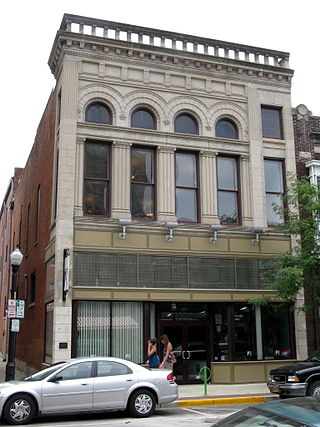
Louis Mohr Block is a historic commercial building located in downtown Fort Wayne, Indiana. It was built in 1891, and is a two-story, five bay, Richardsonian Romanesque style brick building with a three-story rear addition erected in 1926. The front facade features cut limestone cladding on the upper part and round arch windows. The building was remodeled in 1963. For many years the building housed a women's clothing store, The Vogue.
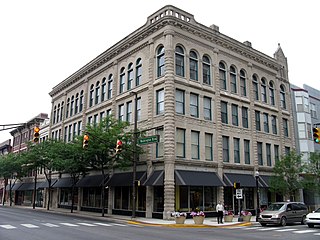
Schmitz Block, also known as the Noll Block, is a historic commercial building located in downtown Fort Wayne, Indiana. It was built in 1888, and is a four-story, "L"-shaped, Richardsonian Romanesque style brick building clad entirely in cut limestone. It features round rock-faced piers which extend the full height of the building and round arch windows. It was remodeled about 1912 after bring purchased by William F. Noll. For many years the building housed Hutner's Paris and Nobbson, a women's clothing store.

Harry A. Keplinger House is a historic home located at Fort Wayne, Indiana. It was built about 1893, and is a 2+1⁄2-story, Richardsonian Romanesque style brick dwelling with a rock-faced stone foundation. It features a steeply pitched roof and dormers, round two-story towers at each of the front corners with conical roofs, and a one-story front porch connecting the two towers. It was built by Harry A. Keplinger, a prominent turn-of-the-20th century businessman.

West Ward School, also known as the West Building Mississinewa Community Schools, is a historic school building located at Gas City, Grant County, Indiana. It was built between 1900 and 1902, and is a 2+1⁄2-story, rectangular, Richardsonian Romanesque style brick and stone building. It features a symmetrical main facade with round towers at each corner topped by conical roofs. The building houses a museum and community center.

Kokomo City Building is a historic municipal building located at Kokomo, Indiana. It was designed by the architecture firm of Wing & Mahurin and built about 1893. It is a two-story, Richardsonian Romanesque style brick and limestone building on a raised basement. It features rounded corner towers topped by conical roofs and a central stone arch entrance. In the rear of the building is the former fire station used until 1979.

Ahavas Shalom Reform Temple ) is an historic synagogue building located in Ligonier, Noble County, Indiana at 503 Main Street, built in 1889. It is located in the Ligonier Historic District.
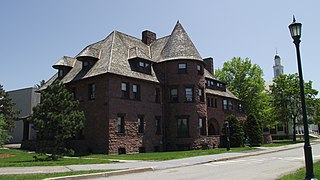
Redstone is a historic former estate on South Prospect Street in Burlington, Vermont. It was developed in 1889, and includes some of Burlington's finest examples of Richardsonian Romanesque, Shingle, and Colonial Revival architecture. Its surviving elements are Redstone Green and some of its surrounding buildings on the campus of the University of Vermont, which acquired the property in 1921, and are part of the university's Redstone Campus. It was listed on the National Register of Historic Places in 1991 as the Redstone Historic District.




